List of Contents
Public Transportation Market Size and Forecast 2025 to 2034
The global public transportation market size was calculated at USD 6.11 billion in 2024, and is projected to be worth around USD 28.89 billion by 2034 at a CAGR of 16.81% from 2025 to 2034.
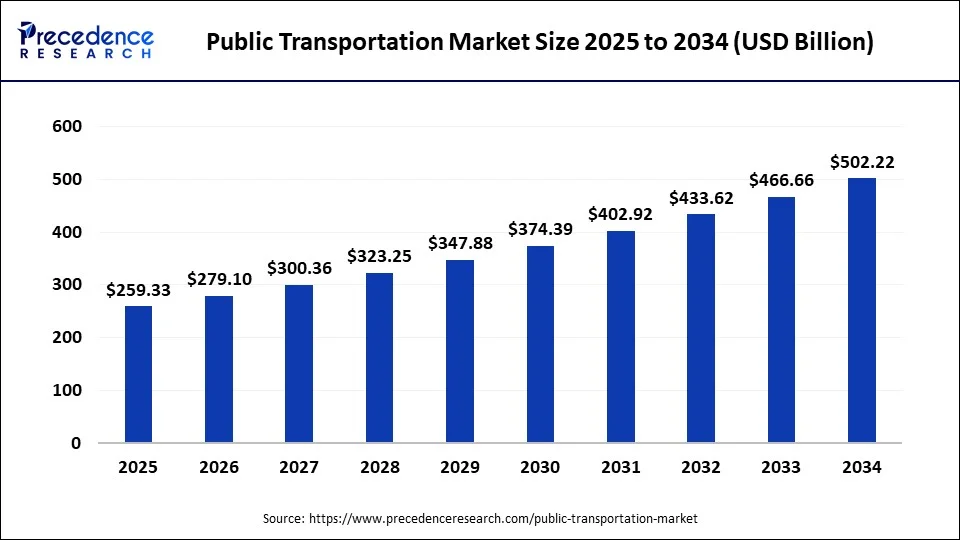
Public Transportation Key Takeaways
- In terms of revenue, the market is valued at $259.33 billion in 2025.
- It is projected to reach $502.22 billion by 2034.
- The market is expected to grow at a CAGR of 16.81% from 2025 to 2034.
- Asia Pacific dominated the market with the largest market share of 47% in 2024.
- North America is projected to expand at a solid CAGR of 7.03% during the forecast period.
- By mode type, the road segment contributed more than 57% of market share in 2024.
- By mode type, the rail segment is expected to grow significantly in the market during the forecast period.
- By distribution channel, the offline segment accounted for the largest market share of 81% in 2024.
- By distribution channel, the online segment is expected to witness significant growth in the market during the forecast period.
Integration of Artificial Intelligence in Public Transport Industry
Artificial Intelligence is now a staple in modern public transport vehicles with features such as automated parking assistance, 360-degree cameras, and in-cabin monitoring for the safety of passengers and drivers. Predictive analytics and AI algorithms are used for object detection for driving engineers that minimizes the risks of possible threats or accidents. The software-integrated cameras help with visualization and computational photography with the help of sensors. Customer-service chatbots assist the public in real-time vehicle tracking and automated vehicles analyze driver behavior patterns for overall security. Natural language processing ensures the correct communication and customer query-solving approach.
- In May 2024, Renault group announced its upcoming launch of autonomous vehicles for public transportation with advanced driver assistance systems and aiming at reducing carbon emissions by providing great comfort and safe traveling experience to the people.
Asia Pacific Public Transportation Market Size and Growth 2025 to 2034
The Asia Pacific public transportation market size is exhibited at USD 121.89 billion in 2025 and is projected to be worth around USD 236.04 billion by 2034, poised to grow at a CAGR of 7.66% from 2025 to 2034.
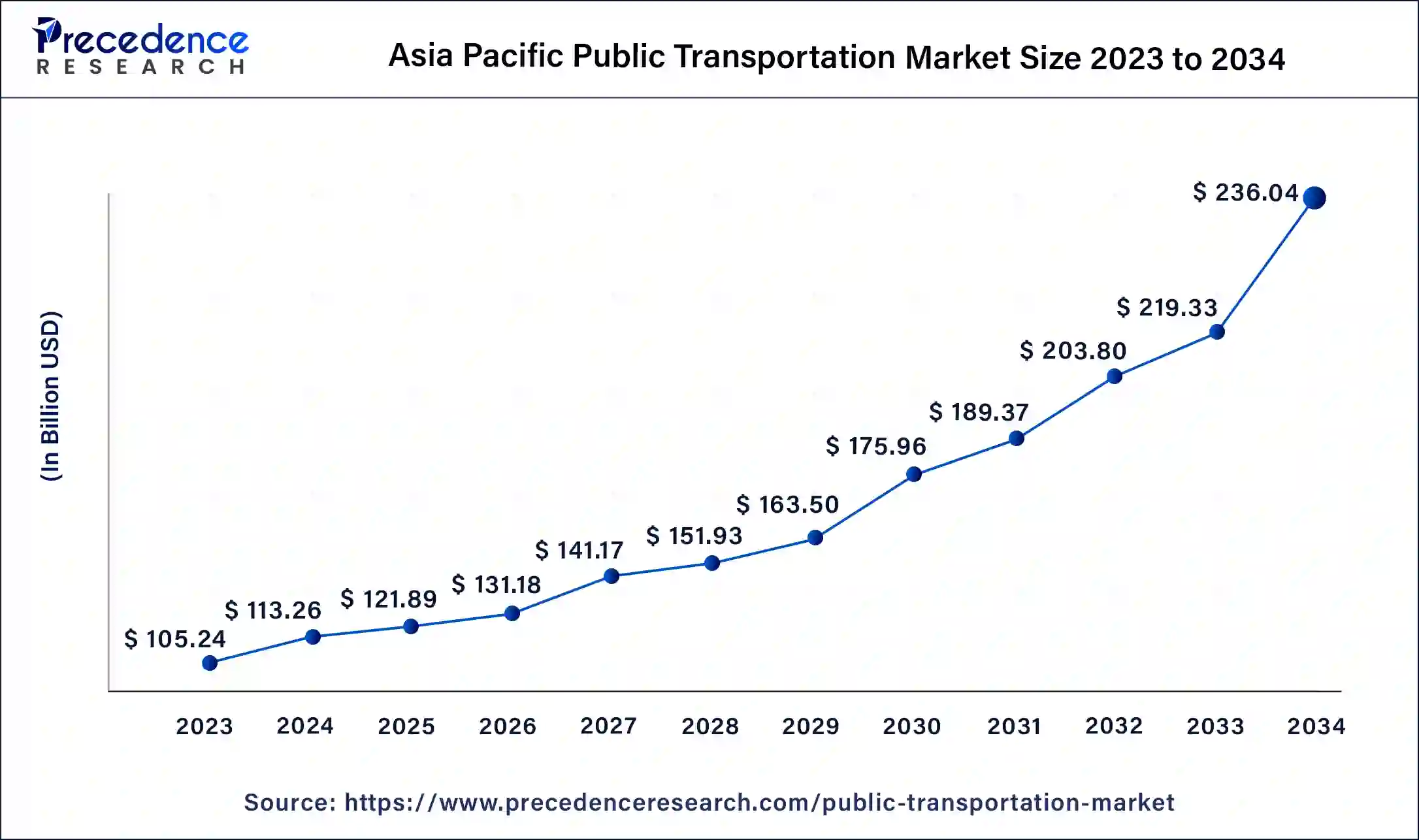
Asia Pacific held the dominant share of the public transportation market in 2024 and is expected to witness prolific growth during the forecast period. Developing countries such as China, Japan, and India are the leading contributors to the market owing to rapid urbanization, the presence of stringent emission norms and regulations, increasing development of charging infrastructure, a significant rise in population, and rising traffic congestion, which facilitates the sophisticated development of public transportation systems to reduce traffic congestion and pollution as well as providing accessible mobility options.
The rising adoption of emerging technology is anticipated to enhance the safety, efficiency, and convenience of public transportation. Moreover, the government is actively engaged in investments and supportive initiatives for infrastructure development, including rail networks, metro systems, and bus rapid transit systems to improve public transportation networks and promote sustainable transportation options among lower and middle-class people.
Furthermore, reasonably priced public transportation is accelerating the expansion of the market as the region has a large population of lower and middle-income individuals who cannot afford private vehicles; instead, they rely on public transit for their daily commute. Therefore, such factors are responsible for making the region a key catalyst for the robust growth of the public transportation market.
- In March 2024, Prime Minister of India Narendra Modi on Monday inaugurated and laid the foundation stone of 112 National Highway (NH) projects spread across the country worth over ₹1 lakh crore at Gurugram. The projects include development works from Karnataka, Kerala, and Andhra Pradesh in South India, Uttar Pradesh and Haryana in North India, West Bengal and Bihar in East India, and Maharashtra, Punjab, and Rajasthan in West India.
- In 2022, the Government of India launched the ambitious National Electric Bus Program (NEBP) to improve and encourage clean fuel-based public transportation. NEBP envisaged the deployment of 50,000 electric buses across the country by 2030. The program will be run by CESL, which will aggregate demand from various cities and conduct the tender process with homogenized bus specifications to benefit from economies of scale. The program is backed by a significant investment of INR 820 billion ($10 billion).
- In March 2024, Uzbekistan is looking to China for help in upgrading the Uzbek rail system. A delegation from the Chinese locomotive and rolling stock manufacturer CRRC held talks in Tashkent in late February with the state rail company Uzbekistan Railways JSC. Discussions focused on the ‘modernization of electric locomotives and localization of production,' according to the Uzbek company's statement.
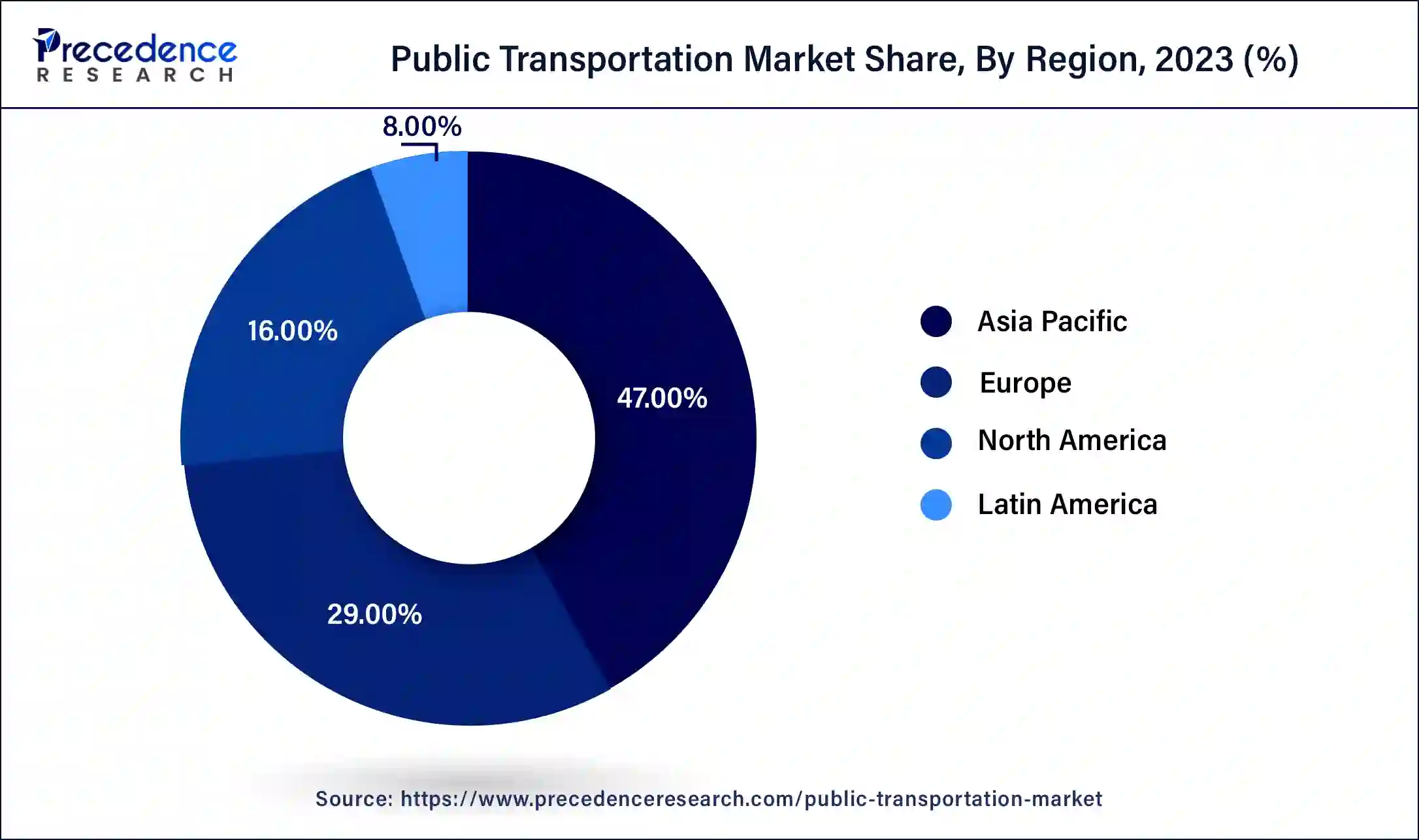
North America is observed to expand at a rapid pace in the public transportation market during the forecast period. The market has witnessed a rising demand for affordable public transportation owing to the high cost of private transportation in the region. Additionally, the government's rising investment is expected to facilitate access to affordable public transportation facilities, which further reduce congestion, lower carbon emissions, and combat climate change. The presence of sophisticated charging infrastructure for electric buses, coupled with rapid technological advancements, including mobile ticketing and real-time transport information systems (RTIS), improves the commuters' experience. Thereby fostering the growth of the North American market.
- In November 2023, California's Department of Transportation is doing the most among its peers to improve climate and equity outcomes, according to a scorecard released by the Natural Resources Defense Council, an environmental advocacy group. The report provides a picture of the national transportation policy landscape as state DOTs prepare to allocate new federal funding from the Infrastructure Investment and Jobs Act.
- In June 2024, the Canadian government is taking positive steps toward more sustainable transit with a significant investment in electric vehicles. With support from the Canadian federal government, British Columbia is investing in 115 electric buses and accompanying charging infrastructure. The first group of 66 vehicles is expected to arrive in batches between 2025 and 2026. This electrification project follows similar steps in other regions of the Great White North.
Europe Public Transportation Market Trends
The European public transportation market is expected to witness significant growth over the forecast period. They are propelled by ambitious government programs aimed at decreasing carbon emissions and the spread of sustainable mobility. Development in the transportation sector is greatly investing in green transport infrastructures through hydrogen-powered buses, electrified rail networks, smart ticketing, and others in the countries of the region. Europe has a wide coverage of buses, subways, trams, and trains, thereby creating an easily accessible and economical mode of transport.
The UK contributes significantly to the European picture of the rise in the scope of the sphere of public transportation. Substantial funds are also being invested in the electrification of rail routes, the expansion of bus networks in some of the urban areas, and the creation of low-emission zones in such prominent cities as London and Manchester. Also, increasing usage of digital solutions to monitor the current location, plan the route, and make payments without contact supports further convenience and promotes the increased popularity of public transportation in the UK.
In December 2024, the European Investment Bank (EIB) pledged €16.5 million for the development of new public transport in urban areas of Ukraine impacted by conflict, intending to reconstruct and upgrade vital infrastructure.
(Source: https://www.eib.org)
Technology Advancement
The transportation sector is a fast-changing business sector due to advancements in technology. Factors like the improvement of efficiencies, an increase in safety, and sustainability of the public transport systems include innovations like electric cars, autonomous electric cars, real-time tracking systems, contactless payment methods, and the use of AI in managing traffic within cities. Integrated apps and data analytics are enhancing the intended passenger experience and planning of operations, with the help of smart mobility solutions.
Market Overview
The public transportation market provides transportation services to the public using several modes of shared mobility. It comprises numerous modes, including buses, subways, trains, and others. Public transportation services play an integral role in facilitating the movement of people within cities and metropolitan areas, which aids in reducing traffic congestion, lowering the environmental impact, and fostering sustainable urban development. Public transportation services are generally operated and managed by government bodies, municipal authorities, or public agencies.
Public Transportation Market Growth Factors
- The increasing production and sales of EV buses are expected to boost the growth of the public transportation market.
- The rapid urbanization coupled with the rising population is majorly boosting the market's expansion during the forecast period.
- The robust growth in transport infrastructure is expected to contribute to the public transportation market growth.
- The integration of smart cities and digitalization in public transportation systems is projected to propel the growth of the public transportation market in the coming years.
- The increasing usage of public transportation for domestic trips is driving the market growth.
Market Scope
| Report Coverage | Details |
| Market Size by 2034 | USD 502.22 Billion |
| Market Size in 2025 | USD 259.33 Billion |
| Market Size in 2024 | USD 240.97 Billion |
| Market Growth Rate from 2025 to 2034 | CAGR of 7.62% |
| Largest Market | Asia Pacific |
| Base Year | 2024 |
| Forecast Period | 2025 to 2034 |
| Segments Covered | Mode Type, Distribution Channel, and Regions |
| Regions Covered | North America, Europe, Asia-Pacific, Latin America and Middle East & Africa |
Market Dynamics
Drivers
Increasing adoption of electric bus
The significant rise in electric bus adoption due to the rise in environmental concerns globally is expected to accelerate the growth of the public transportation market. Electric bus adoption in public transportation is growing all over the world. The surge in pollution levels and the adverse effects of greenhouse gas emissions on the environment have boosted the demand for eco-friendly vehicles. The usage of electric or hybrid buses and trains reduces the dependency on fossil fuels and promotes greener transportation. Therefore, the increasing manufacturing of electric buses for public transportation will largely contribute to the market's growth during the forecast period.
The European e-bus market saw a 53% growth in registrations last year: in 2024, as many as 6,354 were registered in EU27 + Norway, Iceland, and Switzerland. Over 42% of city buses were zero-emission (BEV and Hydrogen), quickly growing from 15% in 2020. According to figures by Chatrou CME Solutions, Overall, 13,466 buses with alternative drivelines were registered, reflecting a 41% increase from the previous year.
- In August 2023, India approved plans for a USD 7 billion electric bus. India aims to introduce electric buses in nearly 170 cities as part of the country's efforts to reduce air pollution and promote sustainable transportation. The government eventually wants to introduce 50,000 electric buses nationwide at an estimated cost of USD 12 billion.
- In April 2024, A leading tourist transport operator in Malta added four electric buses produced by Chinese manufacturer Yutong Bus Co Ltd to its fleet, which is in line with its commitment to go green and curb emissions.
Restraint
Increasing preference for passenger vehicles and two-wheelers
The growing sales of passenger vehicles and two-wheelers are anticipated to hamper the market's growth. In recent years, the market has witnessed an increase in the purchase of passenger vehicles and two-wheelers, which has reduced the usage of public transportation among the general public. Thus, increasing the number of private and personal modes of transportation has resulted in the rising utilization of public transportation and may restrict the expansion of the global public transportation market.
According to the Society of Indian Automobile Manufacturers (SIAM):
- Passenger vehicle sales were up 4%, and two-wheelers 10% on-year in May.
- In its latest report on auto sales in June, passenger vehicle sales were up 3 % as compared to the previous month. It said that 3,37,757 units of passenger vehicles were sold in June, while 59,544 units of three-wheelers and 16,14,154 units of two-wheelers were sold in the same period, registering a growth of 12.3 % and 21.3 % respectively.
- In the April-June quarter, 10,26,006 units of passenger vehicles, 2,24,209 units of commercial vehicles, 1,65,081 units of three-wheelers, and 49,85,631 units of two-wheelers were sold. As many as 75,48,668 units of passenger vehicles, commercial vehicles, three-wheelers, two-wheelers, and quadricycles were sold in the April-June quarter.
Opportunity
Supportive government framework
The supportive role of the government is projected to create significant growth opportunities for the growth of the global public transportation market during the forecast period. Governments around the world are promoting travel through public transportation by offering low-cost fares and providing free services to some age and female categories. The surge in the number of private vehicles on roads causes traffic congestion and environmental issues, which compels government bodies and travel agencies to work in collaboration to resolve this issue by promoting public transportation modes among commuters.
Reducing traffic congestion requires sustainable public transportation and further increases the usage of rail, metro, and bus rapid transit. The government is highly investing in developing smart cities with advanced public transportation infrastructure. Cities are facilitated with efficient public transportation and urban mobility. Several governments have announced tax exemptions and subsidies for the purchase of electric buses to promote green transportation. Thus, Governments play an integral part in promoting public transportation through the execution of policies, regulations, and investments and are expected to drive the public transportation market during the forecast period.
- In July 2024, the Karnataka State Road Transport Corporation (KSRTC) announced its plan to roll out 300 electric buses for efficient, eco-friendly intercity travel. The KSRTC has issued a tender for these buses, which will operate under a Gross Cost Contract (GCC) model over 12 years.
- In April 2024, The Norwegian government unveiled an NKr 435bn (USD40.13bn) proposed budget for investment in railway infrastructure under the latest 12-year National Transport Plan 2025-2036.
- In June 2022, The Federal Railroad Administration (FRA) announced over USD368 million in Consolidated Rail Infrastructure and Safety Improvements (CRISI) grant program funds to 46 projects in 32 states and the District of Columbia. These investments will play a crucial role in modernizing our country's rail infrastructure and strengthening supply chains, helping to reduce congestion and get people and goods where they need to go quickly and more affordably.
Mode Type Insights
The road segment held the largest share of the public transportation market in 2024 and is expected to sustain its position throughout the forecast period. The road segment held the largest segment of the public transportation market in 2023, and the segment is expected to sustain its position throughout the forecast period owing to the increasing demand for affordable and accessible transportation facilities. In public transportation, roads play an essential role by offering feasible solutions and necessary infrastructure for efficient transportation networks, as well as reducing the impact of traffic congestion on modern roads.
The establishment of well-developed road networks enables the seamless flow of public transit vehicles and allows travelers to reach their destinations safely and quickly. High-quality roads for buses and rapid transit systems improve efficiency and enhance the speed of public transportation, making it a cost-effective option for commuters. The widespread adoption of EV buses, coupled with increasing usage of a bus rapid transit system in various megacities globally, is expected to accelerate the growth of the public transportation market.
- In February 2024, FlixBus announced its launch in India. FlixBus, a German transportation company, has announced its entry into the Indian market and aims to transform intercity bus travel in India. The company promises to offer travel options at competitive prices and best-in-class safety standards. FlixBus will initially operate on routes in Northern India, connecting Delhi with Ayodhya, Chandigarh, Jaipur, Manali, Haridwar, Rishikesh, Ajmer, Katra, Dehradun, Gorakhpur, Varanasi, Jodhpur, Dharamshala, Lucknow, and Amritsar.
- In August 2022, the Union Minister for Road Transport and Highways of India inaugurated and laid the foundation stone of 6 National Highway projects of 119 Kms worth Rs. 2300 Crore in Indore, Madhya Pradesh. In addition, In April 2022, the Union Minister for Road Transport and Highways of India inaugurated 7 National Highway Projects worth Rs.5569 crores in Aurangabad, Maharashtra.
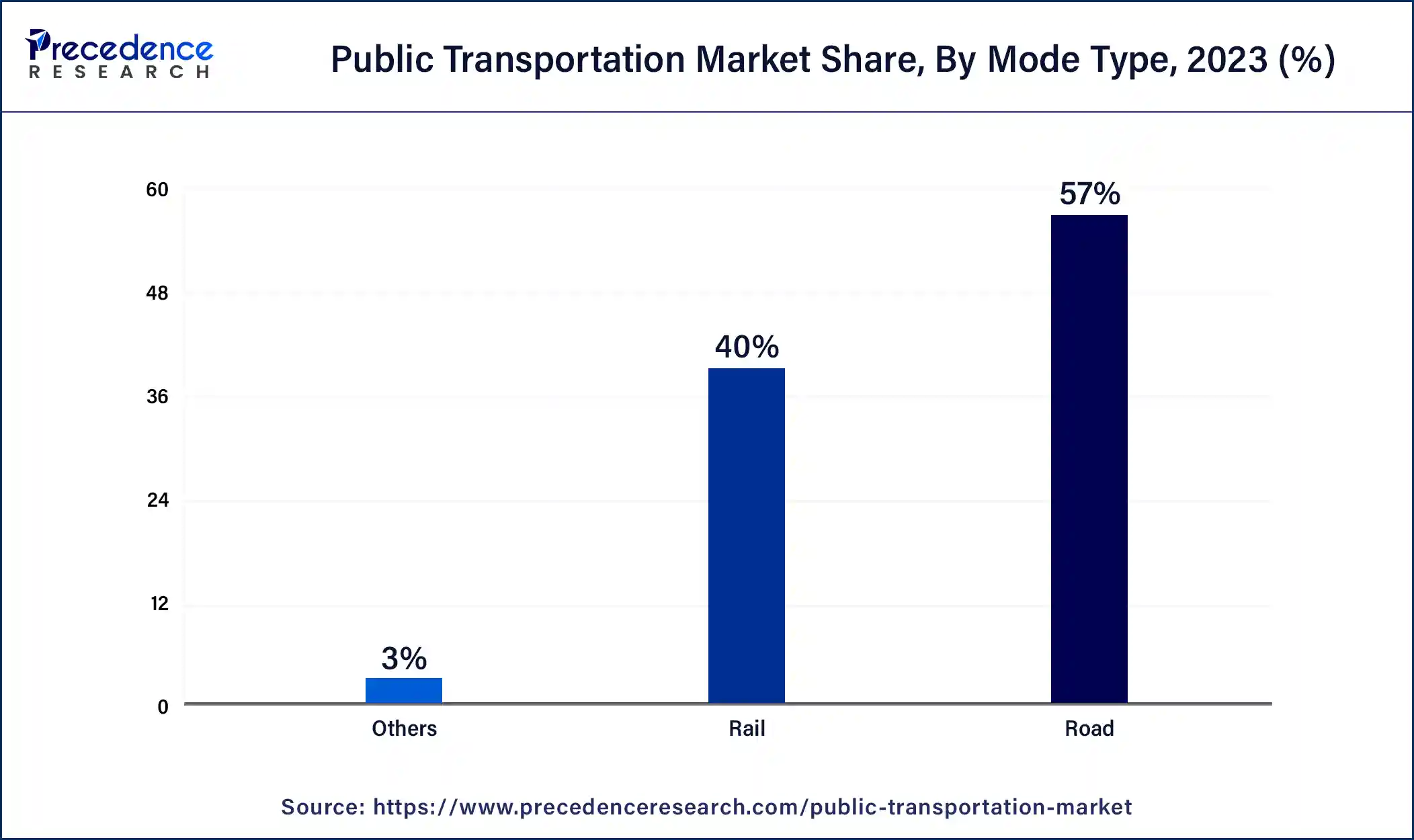
The rail segment is expected to grow significantly in the public transportation market during the forecast period. Rail transportation plays a crucial role in offering reliable, congestion-reducing transportation solutions, reducing travel times, and providing quick modes of transportation. Rail systems include subways, metros, and light rail. Rail transport is highly preferable for long distances at low prices and also increases the travel of people across cities and rural areas.
The growth of the rail segment is majorly driven by the increasing traffic congestion on the roads owing to the rise in the number of private and public vehicles, which increases the travel time. Rail transport uses advanced driver assistance systems (ADAS) to improve safety, enhance operational management, reduce costs, and optimize energy consumption. Additionally, governments around the world are increasingly investing in expanding and improving rail infrastructure to address traffic congestion and promote sustainable transportation options. Such factors are propelling the growth of the segment during the forecast period.
- In December 2024, the U.S. Department of Transportation's Federal Railroad Administration (FRA) announced that it had awarded $8.2 billion for ten passenger rail projects across the country while announcing corridor planning activities that will impact every region nationwide. This unprecedented investment in America's nationwide intercity passenger rail network builds on a $16.4 billion investment announced last month for 25 projects of national significance along America's busiest rail corridor.
- According to the IBEF, As of FY22, the Indian Railway network spans over 68,103 kilometers, up from 65,810 km in FY14. Indian Railways is the largest rail network in Asia and the world's second-largest network managed by a single administration. The Interim Budget 2024-25 allocated US$ 30.8 billion (Rs. 2.55 lakh crore) to Indian Railways with a focus on investing in the modernization of the railways.
Distribution Channel Insights
The offline segment led the public transportation market in 2024. This segment is an established and oldest form of distribution channel in the public transport industry. Offline distribution channels include buses, trains, metro, and ferries that operate on fixed routes and schedules. It is a widely used distribution channel for public transit ticketing. Offline distribution channels include agents, ticket counters, kiosks, and others located at transportation stations and terminals. Offline mode distribution channels offer face-to-face interactions and provide convenience in purchasing tickets and other related information services, such as inquiring about routes and schedules and receiving personalized assistance.
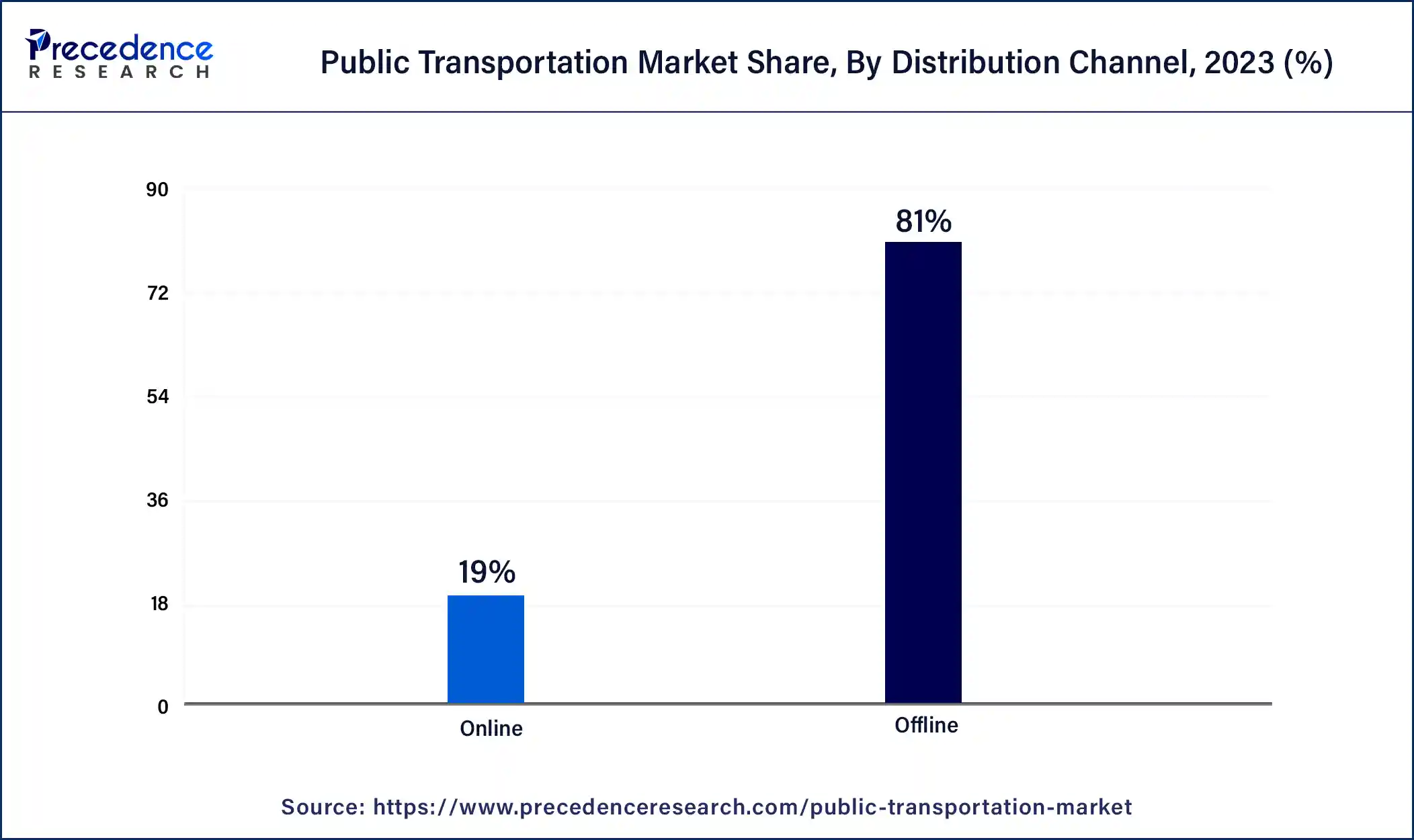
The online segment is observed to grow at a notable rate in the public transportation market during the forecast period. The rapid pace of digitization globally is reshaping public transportation and offering travelers comfort and convenience through real-time information. The online platform allows users to access real-time information, purchase tickets, plan routes, make contactless payments, reduce waiting times, and improve overall travel experiences. The increasing penetration of internet connectivity, rising usage of smartphones, and surge in the number of tourists are fueling the growth of the segment during the forecast period.
- In March 2024, Sweden announced the launch of a central booking system for public transport. Sweden has become the first country in Europe to use the OSDM online standard for public transport booking processes at a nationwide level with the launch of a National Distribution System (NDS) developed by Samtrafiken, allowing customers to book tickets from more than 50 Swedish rail and bus operators.
Public Transportation Market Companies
- Transdev
- Mass Transit Railway (MTR)
- The Brussels Transport Company
- Transport for London (TfL)
- Transport International Holding Limited
- Metropolitan Transportation Authority
- Southern California Regional Rail Authority (Metrolink)
- BC Transit Corporation
- Berliner Verkehrsbetriebe
- Deutsche Bahn
- East Japan Railway Company
- Keolis
- Trenitalia c2c Limited
- TOBU RAILWAY Co. LTD.
- Toronto Transit Commission
Recent Developments
- In September 2023, Mr. Biden and Prime Minister Narendra Modi plan to announce the project as part of the Partnership for Global Infrastructure Investment. The rail and shipping corridor would enable greater trade among the countries, including energy products.
- In May 2024, Renault Group announced its plan to launch an ambitious level 4 offer for public transportation. Renault Group is developing an electric, robotized, and pre-equipped miniBus platform that will host various automation solutions from specialist partners. Renault Group is collaboration with WeRide, a world-renowned expert in autonomous driving, for the large-scale commercial deployment of vehicles with an L4 level of autonomy.
Segments Covered in the Report
By Mode Type
- Road
- Rail
- Others
By Distribution Channel
- Online
- Offline
By Geography
- North America
- Asia Pacific
- Europe
- Latin America
- Middle East & Africa
For inquiries regarding discounts, bulk purchases, or customization requests, please contact us at sales@precedenceresearch.com
Frequently Asked Questions
Ask For Sample
No cookie-cutter, only authentic analysis – take the 1st step to become a Precedence Research client